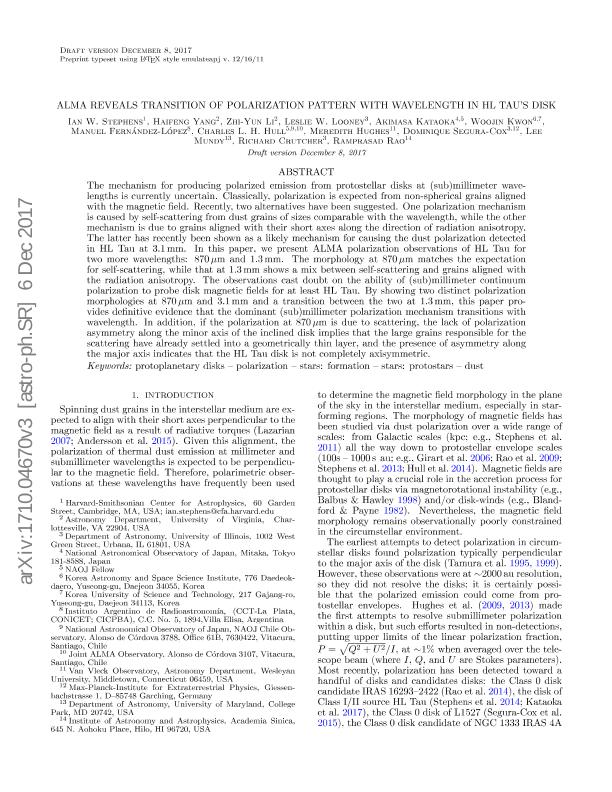Mostrar el registro sencillo del ítem
dc.contributor.author
Stephens, Ian W.
dc.contributor.author
Yang, Haifeng
dc.contributor.author
Li, Zhi-Yun
dc.contributor.author
Looney, Leslie W.
dc.contributor.author
Kataoka, Akimasa
dc.contributor.author
Kwon, Woojin
dc.contributor.author
Fernandez Lopez, Manuel

dc.contributor.author
Hull, Charles L. H.
dc.contributor.author
Hughes, Meredith
dc.contributor.author
Segura Cox, Dominique
dc.contributor.author
Mundy, Lee
dc.contributor.author
Crutcher, Richard
dc.contributor.author
Rao, Ramprasad
dc.date.available
2018-08-21T17:43:46Z
dc.date.issued
2017-12
dc.identifier.citation
Stephens, Ian W.; Yang, Haifeng; Li, Zhi-Yun; Looney, Leslie W.; Kataoka, Akimasa; et al.; ALMA Reveals Transition of Polarization Pattern with Wavelength in HL Tau's Disk; IOP Publishing; Astrophysical Journal; 851; 1; 12-2017
dc.identifier.issn
0004-637X
dc.identifier.uri
http://hdl.handle.net/11336/56346
dc.description.abstract
The mechanism for producing polarized emission from protostellar disks at (sub)millimeter wavelengths is currently uncertain. Classically, polarization is expected from non-spherical grains aligned with the magnetic field. Recently, two alternatives have been suggested. One polarization mechanism is caused by self-scattering from dust grains of sizes comparable with the wavelength, while the other mechanism is due to grains aligned with their short axes along the direction of radiation anisotropy. The latter has recently been shown as a likely mechanism for causing the dust polarization detected in HL Tau at 3.1 mm. In this paper, we present ALMA polarization observations of HL Tau for two more wavelengths: 870 μm and 1.3 mm. The morphology at 870 μm matches the expectation for self-scattering, while that at 1.3 mm shows a mix between self-scattering and grains aligned with the radiation anisotropy. The observations cast doubt on the ability of (sub)millimeter continuum polarization to probe disk magnetic fields for at least HL Tau. By showing two distinct polarization morphologies at 870 μm and 3.1 mm and a transition between the two at 1.3 mm, this paper provides definitive evidence that the dominant (sub)millimeter polarization mechanism transitions with wavelength. In addition, if the polarization at 870 μm is due to scattering, the lack of polarization asymmetry along the minor axis of the inclined disk implies that the large grains responsible for the scattering have already settled into a geometrically thin layer, and the presence of asymmetry along the major axis indicates that the HL Tau disk is not completely axisymmetric.
dc.format
application/pdf
dc.language.iso
eng
dc.publisher
IOP Publishing

dc.rights
info:eu-repo/semantics/openAccess
dc.rights.uri
https://creativecommons.org/licenses/by-nc-sa/2.5/ar/
dc.subject
Dust, Extinction
dc.subject
Polarization
dc.subject
Protoplanetary Disks
dc.subject
Stars: Formation
dc.subject
Stars: Protostars
dc.subject.classification
Astronomía

dc.subject.classification
Ciencias Físicas

dc.subject.classification
CIENCIAS NATURALES Y EXACTAS

dc.title
ALMA Reveals Transition of Polarization Pattern with Wavelength in HL Tau's Disk
dc.type
info:eu-repo/semantics/article
dc.type
info:ar-repo/semantics/artículo
dc.type
info:eu-repo/semantics/publishedVersion
dc.date.updated
2018-08-13T17:57:35Z
dc.journal.volume
851
dc.journal.number
1
dc.journal.pais
Reino Unido

dc.journal.ciudad
Londres
dc.description.fil
Fil: Stephens, Ian W.. Harvard-Smithsonian Center for Astrophysics; Estados Unidos
dc.description.fil
Fil: Yang, Haifeng. University of Virginia; Estados Unidos
dc.description.fil
Fil: Li, Zhi-Yun. University of Virginia; Estados Unidos
dc.description.fil
Fil: Looney, Leslie W.. University of Illinois; Estados Unidos
dc.description.fil
Fil: Kataoka, Akimasa. National Astronomical Observatory Of Japan; Japón
dc.description.fil
Fil: Kwon, Woojin. Korea Astronomy And Space Science Institute; Corea del Sur. Korea University of Science and Technology; Corea del Sur
dc.description.fil
Fil: Fernandez Lopez, Manuel. Provincia de Buenos Aires. Gobernación. Comisión de Investigaciones Científicas. Instituto Argentino de Radioastronomía. Consejo Nacional de Investigaciones Científicas y Técnicas. Centro Científico Tecnológico Conicet - La Plata. Instituto Argentino de Radioastronomía; Argentina
dc.description.fil
Fil: Hull, Charles L. H.. Atacama Large Millimeter-submillimeter Array; Chile. National Astronomical Observatory Of Japan; Japón
dc.description.fil
Fil: Hughes, Meredith. Wesleyan University; Estados Unidos
dc.description.fil
Fil: Segura Cox, Dominique. Max Planck Institut Fur Extraterrestrische Physik; Alemania. University of Illinois; Estados Unidos
dc.description.fil
Fil: Mundy, Lee. University of Maryland; Estados Unidos
dc.description.fil
Fil: Crutcher, Richard. University of Illinois; Estados Unidos
dc.description.fil
Fil: Rao, Ramprasad. Institute of Astronomy and Astrophysics; Estados Unidos
dc.journal.title
Astrophysical Journal

dc.relation.alternativeid
info:eu-repo/semantics/altIdentifier/doi/https://dx.doi.org/10.3847/1538-4357/aa998b
dc.relation.alternativeid
info:eu-repo/semantics/altIdentifier/url/http://iopscience.iop.org/article/10.3847/1538-4357/aa998b/meta
Archivos asociados
